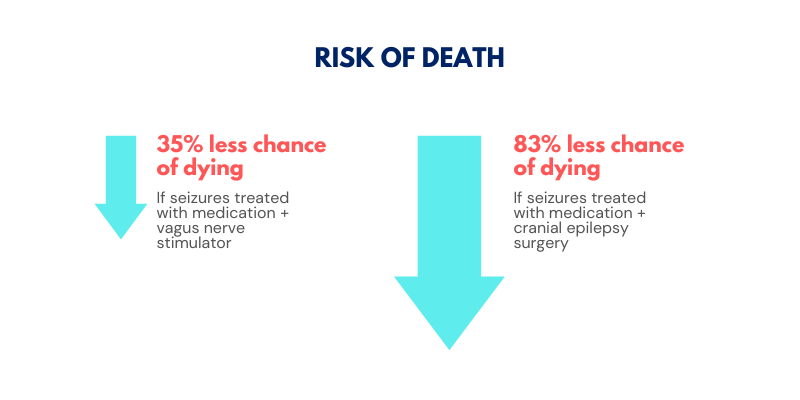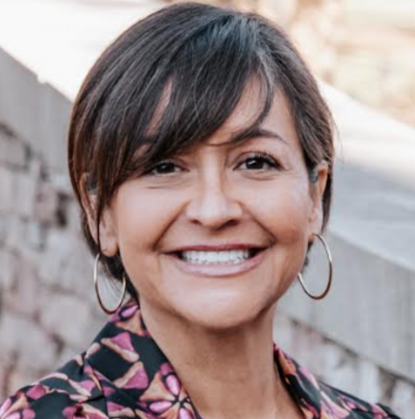Epilepsy and Long-Term Survival
The most frightening fact about epilepsy is that people with epilepsy have a higher chance of dying compared to others their age. It’s one of the main reasons we want parents of children with drug-resistant epilepsy to get to the child to surgical evaluation as soon as possible.
Now, a new study published in The Lancet Child & Adolescent Health shows that delays to surgical evaluation can cost lives.
Risk Factors for Epilepsy-Related Deaths
We know that people with epilepsy die suddenly of unexplained events, suicide, accidents, and severe seizures. Kids and young adults with epilepsy face an even greater risk of death than older people with the condition.
One in 833 children with drug-resistant epilepsy are estimated to die each year of sudden unexplained death in epilepsy (SUDEP).
Uncontrolled Seizures
Children with drug-resistant seizures are at a higher risk of epilepsy-related deaths than those with controlled seizures. Uncontrolled seizures can cause brain damage, respiratory and cardiac dysfunction, and other complications that can be life-threatening.
Seizure Frequency and Severity
Children with frequent and severe seizures are at a higher risk of epilepsy-related deaths than those with infrequent and mild seizures. Seizures that last longer, occur more frequently, or affect multiple areas of the brain can be more difficult to control and can cause more damage to the body.
Comorbid Medical Conditions
Children with epilepsy who have other medical conditions, such as heart disease, diabetes, or respiratory disorders, are at a higher risk of epilepsy-related deaths than those without comorbidities. Medical conditions that affect the heart or lungs can make seizures more dangerous and increase the risk of sudden death.
Epilepsy and Surgery Treatment
In a groundbreaking study, researchers looked at how different treatments – anti-seizure medications only, anti-seizure medications plus vagus nerve stimulation (VNS), and anti-seizure medications plus cranial epilepsy surgery – affect long-term survival in children who don’t respond well to seizure medications.
They reviewed data from over 18,000 children with epilepsy in the United States. The data was collected from over 49 children’s hospitals between 2004 and 2020 and divided into three groups:
-
10,240 children: treated with at least three anti-seizure medications only;
-
5,019 children: anti-seizure medications plus vagus nerve stimulation; and,
-
3,033 children: anti-seizure medications plus cranial epilepsy surgery.
Long-term survival improves after epilepsy surgery
The researchers found that the chances of surviving ten years* was lowest in the group of children treated with only anti-seizure medication. Their ten-year survival rate was 89%.
Children treated with anti-seizure medication and vagus nerve stimulation had a ten-year survival rate of 92%.
Children treated with anti-seizure medication and cranial epilepsy surgery had the highest ten-year survival rate of 98%.
*For the medical therapy group, ten years is measured from date of the third type of anti-seizure medication tried. For the VNS group, ten years is measured from the first admission date of VNS implantation. For the cranial epilepsy surgery, ten years is measured from the date of admission for surgery. Patients who had both VNS and cranial epilepsy surgery were excluded from this study.

Risk of death reduced with epilepsy surgery

“There is lots of work to be done to help kids and their families. This data adds to our ongoing discussions about treatment of pediatric epilepsy, and how we can help outcomes — not just seizure control and quality of life, but long-term survival as well.”Dr. Sandi Lam, study co-author.
What this means for you
If your child has drug-resistant seizures, ask for a surgical evaluation at an epilepsy center with substantial experience treating your child’s epilepsy type. Make sure the whole team is experienced and properly trained. The bigger the surgery, or the newer the technique, the more experience the team will need.
Remember – having a surgical evaluation doesn’t mean you have decided your child will have surgery. It means you want to understand all your options so that you can make an informed health care decision for your child.
Understand all your child’s epilepsy surgery options
There are many surgical options available for your child ranging from minimally invasive techniques like laser ablation all the way to big surgeries like the hemispheric procedures. If your child is not a candidate for cranial epilepsy surgery, vagus nerve stimulation, responsive neurostimulation, or deep brain stimulation can provide hope for an improved quality of life.
Resources to help you navigate your child’s epilepsy surgery journey
- What is an experienced epilepsy surgeon?
- Questions to ask the neurosurgeon
- Financial aid to travel for a surgical evaluation
- Talk to a parent support navigator
Further Reading
- Read the full research paper about this study here (requires purchase): Comparison of long-term survival with continued medical therapy, vagus nerve stimulation, and cranial epilepsy surgery in paediatric patients with drug-resistant epilepsy in the USA: an observational cohort study
- Editorial article by Dr. George Ibrahim about this paper (requires purchase): Medicate or operate: epilepsy surgery could save lives
- A systematic review of sudden unexpected death in epilepsy (SUDEP) in childhood
Important Resources
- Danny Did: Founded by Chicagoans Mike and Mariann Stanton in 2010 after the death of their four-year-old son Danny, the Danny Did Foundation works toward its mission to prevent deaths caused by seizures with these main goals in mind: advancing public awareness of Sudden Unexpected Death in Epilepsy (SUDEP), enhancing SUDEP education and disclosure between medical professionals and families afflicted by seizures, and the mainstreaming of seizure detection and prediction devices that may assist in preventing seizure-related deaths.
- Partners Against Mortality in Epilepsy: PAME’s mission is to convene, educate and inspire all stakeholders – from the bereaved to those living with epilepsy, to health care professionals, advocates, clinical and basic scientists, and death investigators – to promote understanding and drive prevention of epilepsy-related mortality.
You can help us get more children to surgical evaluation by supporting Dreams for Danny, our financial aid program that covers travel costs associated with surgical evaluation. We cover airfare, gas, meals, and other costs insurance won’t pay.
about the author

Monika Jones, JD, is our founder and executive director. Her first son, Henry, had a modified lateral hemispherotomy, revision surgery, then true anatomical hemispherectomy to stop seizures caused by total hemimegalencephaly. She is also the principal investigator of the Global Pediatric Epilepsy Surgery Registry, the only parent-reported data collection to understand the developmental trajectory after pediatric epilepsy surgery. You can read her research works at orcid.org/0000-0001-6086-3236.
Upcoming Events
Recent Posts
Stay Connected
 SUBSCRIBE TO OUR MAILING LIST
SUBSCRIBE TO OUR MAILING LIST

